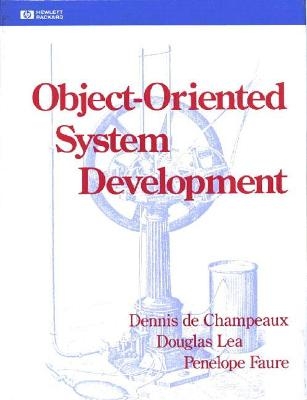
Object-Oriented System Development
Addison-Wesley Educational Publishers Inc (Verlag)
978-0-201-56355-9 (ISBN)
- Titel ist leider vergriffen;
keine Neuauflage - Artikel merken
Although geared to software professionals involved in the development of medium, large, and distributed systems, Object-Oriented System Development is equally valuable to anyone who wants to gain a detailed technical perspective on the object-oriented software development process. "This book (Object-Oriented System Development) is for many different software professionals: analysts, designers, implementors, software engineers, project managers, students and teachers, and others." - Computing Reviews 020156355XB04062001
Dennis de Champeaux is an independent consultant assisting software development organizations in making the shift to object-oriented methods. He was previously software project manager and scientist at HP Labs. Doug Lea is one of the foremost experts on object-oriented technology and software reuse. He has been doing collaborative research with Sun Labs for more than five years. Lea is Professor of Computer Science at SUNY Oswego, Co-director of the Software Engineering Lab at the New York Center for Advanced Technology in Computer Applications, and Adjunct Professor of Electrical and Computer Engineering at Syracuse University. In addition, he co-authored the book, Object-Oriented System Development (Addison-Wesley, 1993). He received his B.A., M.A., and Ph.D. from the University of New Hampshire. Penelope Faure is president of Faure, Inc., a software engineering consulting firm.
1. Overview.
Scope.
Objects.
Development Paradigms.
Development Phases.
Summary.
Further Reading.
Exercises.
I. ANALYSIS.
2. Introduction to Analysis.
Purpose.
Models.
Process.
Summary.
Further Reading.
Exercises.
3. Object Statics.
Instances.
Classes.
Attributes.
Attribute Features.
Constraints.
Identifying Objects and Classes.
Summary.
Further Reading.
Exercises.
4. Object Relationships.
Relationships.
Collections.
Identifying Relationships Summary.
Further Reading.
Exercises.
5. Object Dynamics
Describing Behavior.
Transition Networks.
Examples.
Reducing Complexity.
Summary.
Further Reading.
Exercises.
6. Object Interaction
Transitions.
Sending and Receiving Events.
Interaction Notations.
Examples.
Summary.
Further Reading.
Exercises.
7. Class Relationships
Property Inheritance.
Subclasses.
Multiple Inheritance.
Sibling Relationships.
Set Operations.
Inheritance of Relations.
Summary.
Further Reading.
Exercises.
8. Instances
Subclasses and Instances.
Metaclasses.
Parametric Instances.
Summary.
Further Reading.
Exercises.
9. Ensembles.
Ensembles.
Exposing Constituents.
Other Decomposition Constructs.
Ensembles as Systems.
Summary.
Further Reading.
Exercises.
10. Constructing a System Model.
Requirements Fragment.
Use Cases.
Subsystems.
Vocabulary.
Classes.
Ensembles.
Model.
Summary.
Exercises.
11. Other Requirements.
Resources.
Timing.
Other Constraints.
Summary.
Further Reading.
Exercises.
12. The Analysis Process.
Software Development Process.
Default Sequence of Steps.
OO Analysis of the OO Analysis Process.
Alternative Processes.
Tools.
Summary.
Exercises.
13. Domain Analysis.
Models.
Reuse.
Summary.
Further Reading.
Exercises.
14. The Grady Experience.
II. DESIGN.
15. From Analysis to Design.
Continuity.
Transformation.
Design Phases.
Design Criteria.
Managing Design.
Summary.
Further Reading.
Exercises.
16. Description and Computation.
Translating Analysis Models.
From Abstract to Concrete Concrete.
Composing Classes.
Controlling Transitions.
Generic Classes.
Generating Instances.
Design for Testability.
Transformation and Composition.
Summary.
Further Reading.
Exercises.
17. Attributes in Design.
Defining Attributes.
Concrete Attributes.
Views.
Exports.
Composition and Inheritance.
Summary.
Further Reading.
Exercises.
18. Relationships in Design.
Relationships.
Collections.
Coordinators.
Relations versus Composites.
Summary.
Further Reading.
Exercises.
19. Designing Transitions.
States and Guards.
Atomicity.
Timing Constraints.
Concrete Transitions.
Summary.
Further Reading.
Exercises.
20. Interaction Designs.
Callbacks.
Replies.
Invocations.
Control Flow.
Summary.
Further Reading.
Exercises.
21. Dispatching.
Selection.
Resolution.
Routing.
Summary.
Further Reading.
Exercises.
22. Coordination.
Joint Actions.
Controlling Groups.
Open Systems.
Summary.
Further Reading.
Exercises.
23. Clustering Objects.
Clustering.
Cluster Objects.
System Tools and Services.
Persistence.
Summary.
Further Reading.
Exercises.
24. Designing Passive Objects.
Transformations.
Storage Management.
Passive Objects in C++.
Summary.
Further Reading.
Exercises.
25. Performance Optimization.
Optimization and Evolution.
Algorithmic Optimization.
Performance Transformations.
Optimization in C++.
Summary.
Further Reading.
Exercises.
26. From Design to Implementation.
Testing.
Performance Assessment.
Summary.
Further Reading.
Exercises.
Appendix. Notation.
OAN.
ODL.
Bibliography.
Index. 020156355XT04062001
| Erscheint lt. Verlag | 24.6.1993 |
|---|---|
| Verlagsort | New Jersey |
| Sprache | englisch |
| Maße | 243 x 197 mm |
| Gewicht | 953 g |
| Themenwelt | Mathematik / Informatik ► Informatik ► Datenbanken |
| Informatik ► Software Entwicklung ► Objektorientierung | |
| Mathematik / Informatik ► Informatik ► Theorie / Studium | |
| ISBN-10 | 0-201-56355-X / 020156355X |
| ISBN-13 | 978-0-201-56355-9 / 9780201563559 |
| Zustand | Neuware |
| Haben Sie eine Frage zum Produkt? |
aus dem Bereich


